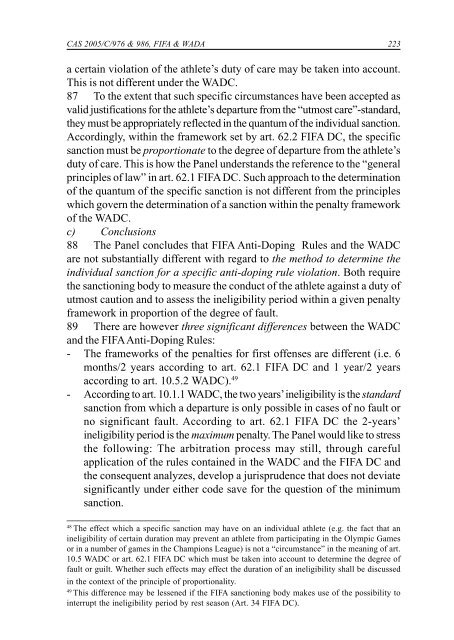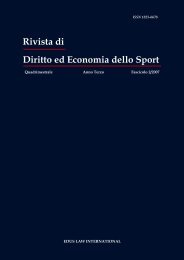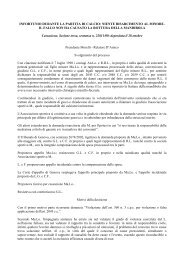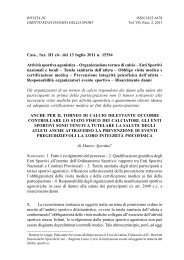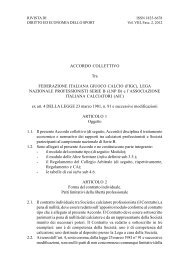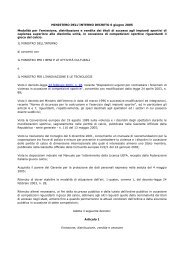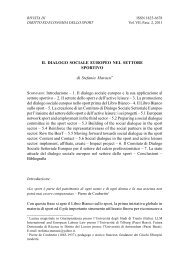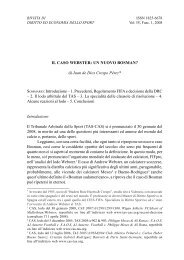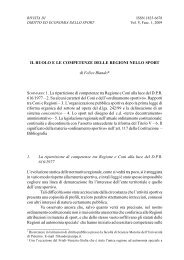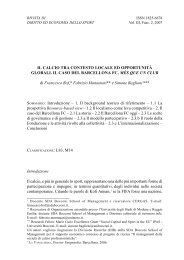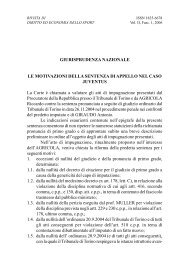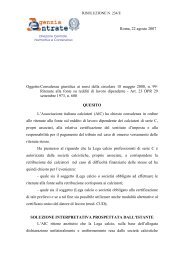Rivista di Diritto ed Economia dello Sport - Rdes.it
Rivista di Diritto ed Economia dello Sport - Rdes.it
Rivista di Diritto ed Economia dello Sport - Rdes.it
You also want an ePaper? Increase the reach of your titles
YUMPU automatically turns print PDFs into web optimized ePapers that Google loves.
CAS 2005/C/976 & 986, FIFA & WADA 223a certain violation of the athlete’s duty of care may be taken into account.This is not <strong>di</strong>fferent under the WADC.87 To the extent that such specific circumstances have been accept<strong>ed</strong> asvalid justifications for the athlete’s departure from the “utmost care”-standard,they must be appropriately reflect<strong>ed</strong> in the quantum of the in<strong>di</strong>vidual sanction.Accor<strong>di</strong>ngly, w<strong>it</strong>hin the framework set by art. 62.2 FIFA DC, the specificsanction must be proportionate to the degree of departure from the athlete’sduty of care. This is how the Panel understands the reference to the “generalprinciples of law” in art. 62.1 FIFA DC. Such approach to the determinationof the quantum of the specific sanction is not <strong>di</strong>fferent from the principleswhich govern the determination of a sanction w<strong>it</strong>hin the penalty frameworkof the WADC.c) Conclusions88 The Panel concludes that FIFA Anti-Doping Rules and the WADCare not substantially <strong>di</strong>fferent w<strong>it</strong>h regard to the method to determine thein<strong>di</strong>vidual sanction for a specific anti-doping rule violation. Both requirethe sanctioning body to measure the conduct of the athlete against a duty ofutmost caution and to assess the ineligibil<strong>it</strong>y period w<strong>it</strong>hin a given penaltyframework in proportion of the degree of fault.89 There are however three significant <strong>di</strong>fferences between the WADCand the FIFA Anti-Doping Rules:- The frameworks of the penalties for first offenses are <strong>di</strong>fferent (i.e. 6months/2 years accor<strong>di</strong>ng to art. 62.1 FIFA DC and 1 year/2 yearsaccor<strong>di</strong>ng to art. 10.5.2 WADC). 49- Accor<strong>di</strong>ng to art. 10.1.1 WADC, the two years’ ineligibil<strong>it</strong>y is the standardsanction from which a departure is only possible in cases of no fault orno significant fault. Accor<strong>di</strong>ng to art. 62.1 FIFA DC the 2-years’ineligibil<strong>it</strong>y period is the maximum penalty. The Panel would like to stressthe following: The arb<strong>it</strong>ration process may still, through carefulapplication of the rules contain<strong>ed</strong> in the WADC and the FIFA DC andthe consequent analyzes, develop a jurisprudence that does not deviatesignificantly under e<strong>it</strong>her code save for the question of the minimumsanction.____________________48The effect which a specific sanction may have on an in<strong>di</strong>vidual athlete (e.g. the fact that anineligibil<strong>it</strong>y of certain duration may prevent an athlete from participating in the Olympic Gamesor in a number of games in the Champions League) is not a “circumstance” in the meaning of art.10.5 WADC or art. 62.1 FIFA DC which must be taken into account to determine the degree offault or guilt. Whether such effects may effect the duration of an ineligibil<strong>it</strong>y shall be <strong>di</strong>scusse<strong>di</strong>n the context of the principle of proportional<strong>it</strong>y.49This <strong>di</strong>fference may be lessen<strong>ed</strong> if the FIFA sanctioning body makes use of the possibil<strong>it</strong>y tointerrupt the ineligibil<strong>it</strong>y period by rest season (Art. 34 FIFA DC).


